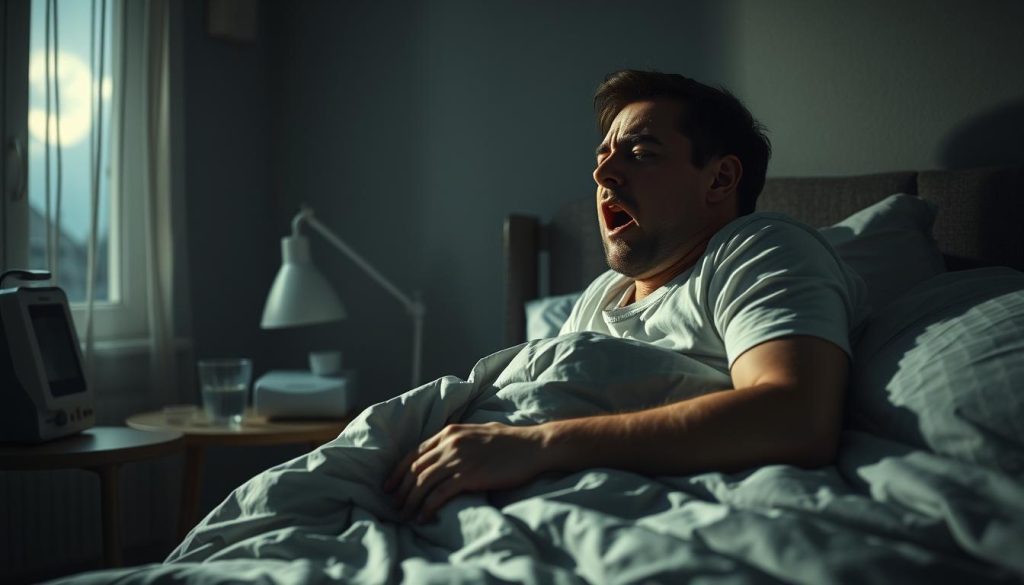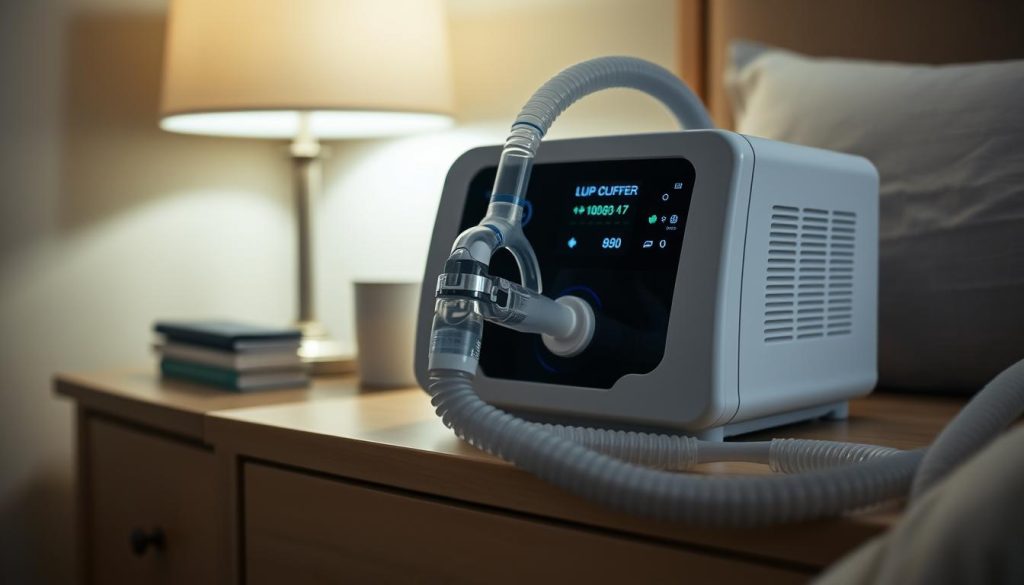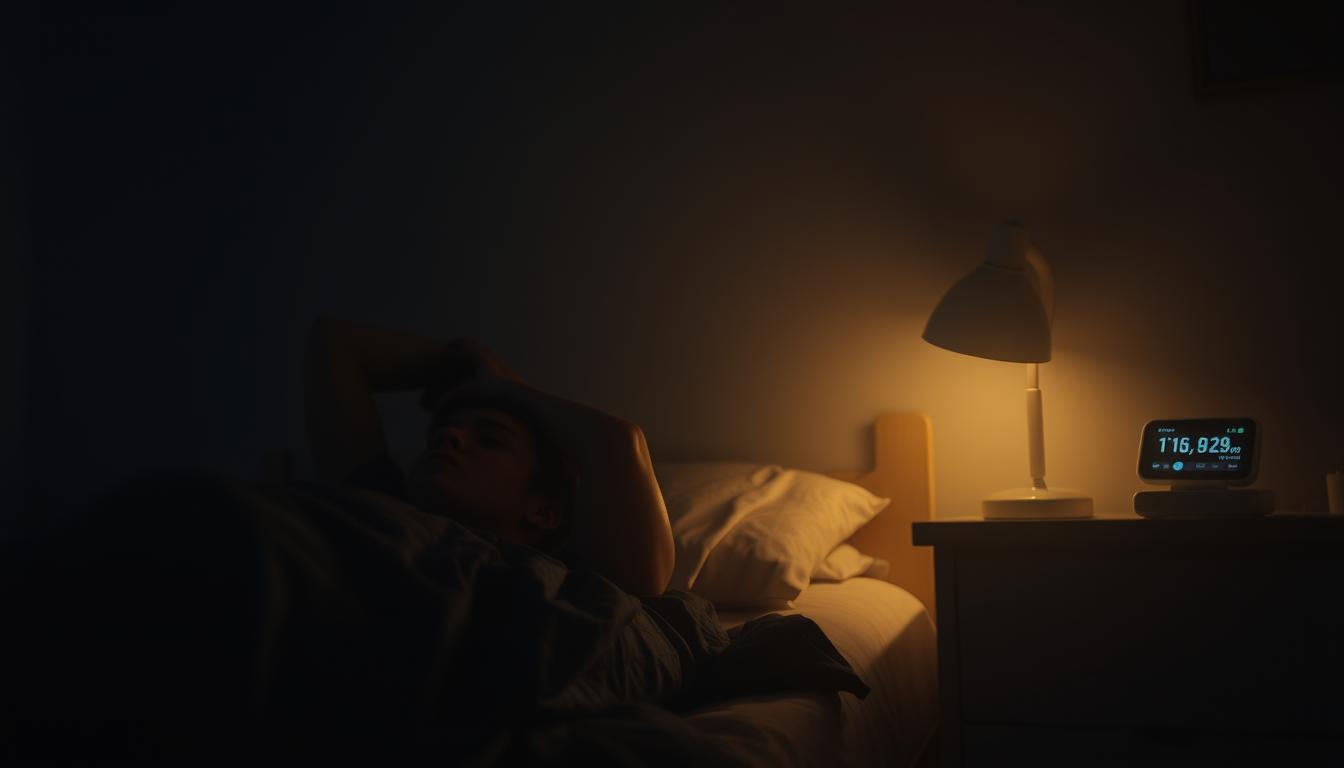Many people don’t realize how closely our physical and emotional well-being are connected. Recent studies show a strong link between sleep apnea and mental health challenges. This article explores this association, offering insights into why it matters.
National surveys reveal that individuals with sleep apnea face higher risks of depression and anxiety. Research also highlights increased odds of psychological distress and even suicidal thoughts. Understanding these connections can help improve overall quality of life.
By addressing sleep apnea, many people experience improvements in their emotional state. This article will guide you through the latest findings, diagnosis methods, and treatment options. Let’s dive into how better sleep can lead to a healthier mind.
Understanding Sleep Apnea: An Overview
Breathing interruptions during rest can signal a deeper health issue. Sleep apnea is a condition where breathing repeatedly stops and starts during sleep. It’s more than just snoring—it’s a serious disorder that can affect your overall well-being.
What is Sleep Apnea?
Sleep apnea occurs when the airway becomes blocked or the brain fails to send proper signals to breathe. The most common type is obstructive sleep apnea (OSA), where throat muscles relax and block airflow. This leads to brief pauses in breathing, often followed by gasping or choking sounds.
These interruptions can happen dozens of times per hour, disrupting rest and reducing oxygen levels in the body. Over time, untreated sleep apnea can lead to serious health problems, including heart disease and high blood pressure.
Types and Prevalence in the United States
There are three main types of sleep apnea: obstructive, central, and complex. Obstructive sleep apnea is the most prevalent, affecting millions of Americans. According to the NSDUH study, about 13% of men and 6% of women in the U.S. experience this condition.
Here’s a breakdown of sleep apnea prevalence by gender:
| Gender | Prevalence |
|---|---|
| Men | 13% |
| Women | 6% |
While occasional breathing pauses are normal, frequent episodes indicate a full-blown disorder. Recognizing the signs early can help prevent long-term health risks. If you suspect sleep apnea, consulting a healthcare professional is crucial.
Exploring Sleep Apnea and Mental Health: Research Insights
Studies reveal a surprising link between nighttime breathing issues and daytime emotional struggles. National surveys and clinical research provide valuable insights into this connection. Let’s dive into the key findings and what they mean for overall well-being.
Key Findings from National Studies
Recent research highlights significant associations between breathing disorders and emotional challenges. For example, one study found that individuals with these conditions are 3.11 times more likely to experience depression. Another study reported a 3.68 times higher risk of anxiety.
Here are some key insights from national studies:
- Increased odds of depression by 3.11 times.
- Higher likelihood of anxiety by 3.68 times.
- Elevated risk of suicidal thoughts in severe cases.
These findings are based on large sample sizes, ensuring their credibility. Researchers used data from reputable surveys, such as the NSDUH, to measure these risks accurately.
Impact on Depression, Anxiety, and Suicidal Thoughts
Understanding odds ratios is key to interpreting these results. An odds ratio of 3.11 means individuals are over three times more likely to experience depression compared to those without breathing issues. Similarly, a ratio of 3.68 indicates a significantly higher risk of anxiety.
These studies also found that untreated conditions can lead to more severe emotional struggles. For instance, prolonged oxygen deprivation during rest may worsen symptoms of depression and anxiety over time.
By addressing these issues early, individuals can reduce their risk of developing serious emotional challenges. This research underscores the importance of seeking professional help for proper diagnosis and treatment.
The Connection Between Sleep Apnea and Mood Disorders
The way we feel during the day often ties back to how well we rest at night. Disrupted rest can lead to emotional instability, making it harder to manage daily stress. This connection is especially strong for those with certain conditions that affect nighttime breathing.
When rest is interrupted, it can have a direct effect on mood. People may feel more irritable, anxious, or even depressed. This is because the brain doesn’t get the chance to recharge properly, leaving emotions on edge.

Stress plays a big role in this cycle. Those with breathing issues often experience higher stress levels, which can worsen mood swings. Over time, this can lead to more serious emotional challenges, like depression or anxiety.
Scientific studies have found that disrupted rest can alter brain chemistry. For example, serotonin levels may drop, affecting how we feel. This neurotransmitter is crucial for maintaining a balanced mood.
Here’s a summary of how disrupted rest affects mood:
| Effect | Outcome |
|---|---|
| Irritability | Increased sensitivity to stress |
| Anxiety | Heightened feelings of worry |
| Depression | Persistent low mood |
Addressing the underlying condition can help break this cycle. Improved rest often leads to better emotional stability and a more positive outlook. Seeking professional help is a crucial step toward managing both the condition and its effects on mood.
Sleep Apnea’s Association with Depression and Suicidal Ideation
Recent findings show a strong tie between breathing disorders and mood instability. Studies reveal that individuals with these conditions face significantly higher risks of depression and suicidal thoughts. Understanding this connection is crucial for improving overall well-being.
Statistical Evidence and Risk Factors
Research highlights alarming statistics. For example, one study found that patients with breathing disorders are 3.11 times more likely to experience depression. Another report showed a 3.68 times higher risk of anxiety. These findings are based on large-scale surveys conducted over several years.
Here are some key risk factors identified in major studies:
- Prolonged oxygen deprivation during rest.
- Frequent interruptions in breathing patterns.
- Untreated conditions leading to worsening emotional challenges.
Longitudinal data spanning multiple years emphasizes the importance of early detection. Addressing these issues promptly can significantly reduce the risk of severe emotional struggles.
The Role of Sleep Disruption in Mental Health
Disrupted rest can have a profound impact on emotional stability. When the brain doesn’t recharge properly, it can lead to irritability, anxiety, and even depression. Over time, this cycle can worsen, increasing the risk of suicidal thoughts.
Specific cases highlight how sleep disruption contributes to mental health deterioration. For instance, patients with untreated breathing disorders often report persistent low mood and heightened stress levels. Addressing the underlying condition can break this cycle and improve emotional well-being.
Early intervention is key. By seeking professional help, individuals can reduce their risk of developing serious emotional challenges. Improved rest often leads to better mental health and a more positive outlook on life.
How Sleep Apnea Impacts Daily Functioning and Quality of Life
Daily life can feel overwhelming when rest is constantly interrupted. Struggling to focus, stay energized, or maintain a positive mood often stems from poor rest quality. These challenges can make even simple tasks seem difficult.
Untreated conditions can lead to frequent fatigue, irritability, and difficulty concentrating. Over time, this can affect work performance, relationships, and overall happiness. Many people find themselves feeling stuck in a cycle of exhaustion and frustration.
Thankfully, effective treatments like CPAP therapy can make a significant difference. Continuous positive airway pressure (CPAP) devices help maintain open airways during rest, reducing interruptions and improving oxygen levels. Studies show that consistent use of CPAP can lead to better focus, improved mood, and higher energy levels.
Here are some ways treatment can enhance daily life:
- Improved concentration and productivity at work or school.
- Reduced irritability and better emotional stability.
- Increased energy for hobbies, exercise, and social activities.
However, adapting to treatment can come with challenges. Some patients find it difficult to adjust to wearing a CPAP mask at first. Others may experience minor discomfort or need time to find the right settings. Despite these hurdles, the long-term benefits often outweigh the initial adjustments.
Lifestyle changes can also play a key role in improving rest quality. Simple steps like maintaining a consistent sleep schedule, avoiding caffeine late in the day, and creating a relaxing bedtime routine can make a big difference. Combining these habits with treatment can lead to even greater improvements in daily functioning.
By addressing the root cause of interrupted rest, individuals can reclaim their energy and enjoy a better quality of life. Seeking professional guidance and exploring treatment options like CPAP therapy are crucial steps toward achieving this goal.
Recognizing the Symptoms of Sleep Apnea
Recognizing the early signs of a breathing disorder can make a significant difference in your health. Many people overlook these symptoms, thinking they’re just part of a busy lifestyle. However, they can be critical red flags for a deeper issue.

Common Warning Signs
Certain symptoms are more noticeable than others. Loud snoring is one of the most common signs, often reported by partners. Gasping or choking during rest is another key indicator that something isn’t right.
Morning headaches and irritability are also frequent complaints. These symptoms can make it hard to focus during the day, affecting work and personal life. Poor concentration and fatigue are often mistaken for stress or lack of rest.
Here’s a quick list of common warning signs:
- Loud snoring
- Gasping or choking during rest
- Morning headaches
- Irritability and mood swings
- Poor concentration and daytime fatigue
When to Ask for a Medical Opinion
If you notice these symptoms persisting, it’s time to consult a dr. Early recognition can lead to better treatment outcomes. Don’t wait until the symptoms start affecting your daily life.
Pay attention to changes in your rest patterns or daytime functioning. These shifts can be subtle but are often the first clue. A dr. can help determine if these symptoms are linked to a breathing disorder or another issue.
Taking proactive steps can improve your quality of life. Don’t hesitate to seek professional advice if you suspect something is wrong. Early intervention can make all the difference.
Diagnostic Tools and Sleep Study Explanations
Diagnosing breathing issues accurately is the first step toward better health. Specialized tests like polysomnography are essential for identifying the root cause of nighttime interruptions. These tools provide detailed insights into breathing patterns, heart rate, and oxygen levels, helping doctors make informed decisions.
Understanding Polysomnography
Polysomnography is the gold standard for diagnosing breathing disorders. This overnight test monitors various body functions during rest. Sensors track breathing, heart rate, oxygen levels, and even brain activity. The data collected helps identify issues like obstructive sleep disorders.
During the test, technicians observe how often breathing pauses occur and how long they last. They also measure airway pressure to assess the severity of the condition. This comprehensive approach ensures an accurate diagnosis, guiding effective treatment plans.
At-Home Testing Options
For those who prefer convenience, at-home testing is an alternative. These portable devices monitor breathing and oxygen levels while you rest in your own bed. While less comprehensive than in-lab studies, they provide valuable insights for initial screening.
Here’s a comparison of in-lab and at-home testing options:
| Feature | In-Lab Polysomnography | At-Home Testing |
|---|---|---|
| Comfort | Sleep in a lab setting | Sleep in your own bed |
| Accuracy | High, with detailed monitoring | Moderate, limited to key metrics |
| Cost | Higher due to lab fees | More affordable |
Both options have their pros and cons. In-lab studies offer detailed data, while at-home tests provide convenience and cost savings. Discussing these choices with a healthcare provider can help determine the best approach for your needs.
Proper diagnosis is crucial for effective treatment. Whether through in-lab polysomnography or at-home testing, identifying the issue is the first step toward better health and improved quality of life.
Treatment Options: From CPAP to Lifestyle Changes
Effective treatment for OSA can transform daily life and restore energy. The right approach often combines advanced devices with simple lifestyle adjustments. This section explores the most effective options for managing this condition.
CPAP and Other Therapeutic Devices
CPAP (Continuous Positive Airway Pressure) is the gold standard for treating OSA. This device uses gentle air pressure to keep the airway open during rest. By preventing interruptions, it ensures proper oxygen flow and improves rest quality.
Other devices, like BiPAP and oral appliances, also help maintain an open airway. BiPAP adjusts pressure levels for inhalation and exhalation, while oral appliances reposition the jaw to reduce blockages. These options are tailored to individual needs, ensuring effective therapy.
Importance of Lifestyle Adjustments
Lifestyle changes play a crucial role in managing OSA. Weight loss, for example, can reduce pressure on the airway, making breathing easier. Regular exercise strengthens muscles and improves overall health, which supports better rest.
Positional therapy is another helpful factor. Sleeping on your side instead of your back can prevent the tongue from blocking the airway. Avoiding alcohol and smoking also reduces airway inflammation, enhancing the effectiveness of therapy.
Here are some key lifestyle adjustments to consider:
- Maintain a healthy weight through diet and exercise.
- Practice positional therapy by sleeping on your side.
- Avoid alcohol and smoking to reduce airway inflammation.
Combining these changes with CPAP or other devices can lead to significant improvements. A tailored approach ensures the best outcomes for managing OSA and restoring energy.
Practical Self-Help Tips for Better Sleep and Mental Well-Being
Small changes in daily habits can lead to big improvements in rest and emotional balance. Whether you’re a young adult or an older person, these tips can help you feel more refreshed and focused. Let’s explore some simple yet effective strategies to enhance your quality of life.
Adapting Your Sleep Positions
Your sleeping position can significantly impact your breathing patterns. Sleeping on your back may cause the tongue to block the airway, leading to interruptions. Experts from the academy sleep medicine recommend side sleeping as a better option.
Here are some tips to adjust your position:
- Use a body pillow to support side sleeping.
- Elevate your head slightly to reduce airway pressure.
- Practice positional therapy by placing a tennis ball in your pajama back to prevent rolling over.

Reducing Alcohol, Smoking, and Stress
Lifestyle choices play a crucial role in maintaining healthy rest patterns. Alcohol and smoking can relax throat muscles, increasing the risk of airway blockages. Reducing or quitting these habits can make a noticeable difference.
Stress management is equally important. High stress levels can disrupt rest and affect overall well-being. Try these techniques:
- Practice mindfulness or meditation before bed.
- Engage in regular physical activity to reduce tension.
- Create a calming bedtime routine to signal your body it’s time to wind down.
Maintaining a consistent schedule is another key factor. Going to bed and waking up at the same time every day helps regulate your internal clock. This is especially beneficial for people of any age looking to improve their rest quality.
By incorporating these self-help strategies, you can take control of your rest and emotional health. Start small, and gradually build these habits into your daily routine for lasting benefits.
Addressing Mental Health with Professional Guidance
Taking care of your emotional well-being is just as important as treating physical symptoms. When dealing with conditions that affect both mind and body, seeking professional help can make a significant difference. Experts emphasize the need for a balanced approach to achieve overall wellness.
Therapy, Medications, and Support Systems
Counseling and cognitive behavioral therapy (CBT) are effective ways to address emotional challenges. These methods help individuals manage stress, improve mood, and develop coping strategies. Many american authors and practitioners highlight the success of these therapies in improving quality of life.
In some cases, medications may be necessary to manage symptoms. Antidepressants or anti-anxiety medications can provide relief when combined with therapy. It’s important to consult a healthcare provider to determine the best treatment plan for your body and mind.
Support systems also play a crucial role. Friends, family, and support groups can offer encouragement and understanding. Building a strong network can help individuals feel less isolated and more empowered to take control of their well-being.
| Treatment Option | Benefits |
|---|---|
| Cognitive Behavioral Therapy | Improves mood and coping skills |
| Medications | Manages symptoms effectively |
| Support Groups | Provides emotional encouragement |
Being proactive about mental health is key. Timely professional guidance can lead to better outcomes and a more balanced life. By addressing both physical and emotional needs, individuals can achieve lasting well-being.
Recent Research and Emerging Trends in Sleep Apnea
Advancements in medical research continue to shed light on the complexities of breathing disorders. Recent studies are uncovering new insights into how these conditions affect overall well-being. This section explores the latest findings and what they mean for future treatment options.
Updates from Scientific Reports and Medical Journals
Cutting-edge research is transforming our understanding of nighttime breathing challenges. Studies published in Scientific Reports highlight the role of airway blockages in disrupting rest. These findings are helping doctors develop more effective diagnostic tools and therapies.
Emerging trends in healthcare focus on personalized treatment plans. For example, new devices are being designed to monitor breathing patterns in real time. This data allows doctors to tailor therapies to individual needs, improving outcomes for patients.
Here are some key developments in the field:
- Advanced diagnostic tools that provide detailed insights into airway function.
- Innovative therapies, such as wearable devices, to manage breathing issues.
- Research into the long-term effects of untreated conditions on overall health.
These breakthroughs are shaping the future of clinical practices. By staying informed, healthcare providers can offer better care and improve patient quality of life. Ongoing research remains essential for advancing our understanding and treatment of these conditions.
Final Thoughts on Embracing Better Sleep and Mental Wellness
Taking small steps toward better rest can lead to significant improvements in emotional balance. This article has highlighted the connection between breathing interruptions and emotional challenges, emphasizing the importance of early detection and treatment.
Combining professional therapies with self-help methods can make a big difference. The American Academy of Sleep recommends consistent attention to rest quality for overall wellness. Simple changes, like adjusting your position or reducing stress, can enhance your daily life.
Remember, progress happens one hour at a time. By focusing on both physical and mental well-being, you can create lasting positive changes. Start today and take control of your journey toward a healthier, happier you.

